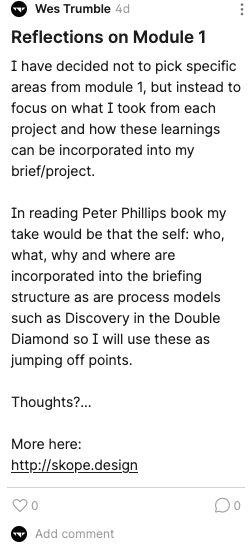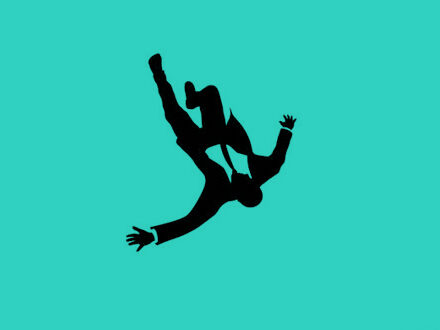Brief analysis | Aims, objectives, brief development and audience
—
Workshop Challenge
PART ONE
Identify the subject of your four week self-initiated project.
Over the course of module 1 during the past 12 weeks I kept notes on potential ideas for projects that could be interesting in the back of my sketch book.
These are:
— Non language based typography
— Accidental design
— Anti-design
— What is 'normal'?
I am also interested in the recent events concerning gas supply and the discovery that carbon dioxide is used in food production, which until now I was completely unaware of.
I have decided not to pick specific areas from module 1, but instead to focus on what I took from each project and how these learnings can be incorporated into my brief/project.
In reading Peter Phillips book my take would be that the self: who, what, why and where are incorporated into the briefing structure, as are process models such as Discovery in the Double Diamond, so I will use these as jumping off points.
THE IDEAS WALL
No responses to my first post (Reflections on Module 1).
On the second post Shinna selected 'D' What is normal?. This is my preferred option. While quite broad at the moment I think I can reduce the question down to tackle specific themes/issues. Tembo likes accidental design but I feel this may be too broad a subject to be able to tackle in the four week timeline.


—
PART TWO
Review of the subjects, research and outputs generated during the GDE710 Contemporary Practice module considering the characteristics of your personal interests, identity and experiences.
In reviewing the first module I have the following questions that may help towards the creation of my brief:
INDUSTRY TODAY
— Will the social, economic, political and technological landscape have any bearing on my brief?
— How will my interests: local, community and environment play a part if at all?
SELF AND IDENTITY
— Can archetypes be used to create the profiles and characteristics of my audience?
THOUGHTS ON IDEAS
— How can I use the double diamond process to define my phases?
RESEARCH AND THEORY
— What philosophical standpoint should I take in developing the brief?
SKILLS AND MAKING
— How can I close the current gaps identified in my working process: Research and costing?
TRENDS AND ENVIRONMENTS
— Can semiotics play a role in the development of the brief?
NEW STEPS
— Will the final outcome be an opposing media or environment (e.g. from book to installation, packaging to performance) or an opposing time or fictional future (e.g. speculative design)?
GENERAL NOTES:
— To simplify information for my audience. How will it engage with the intended audience?
— To understand the culture I am working in. Are there any barriers to entry: Language, typeface, colours, images and sound.
— To think about the whole problem, not one part in isolation.
& the following take outs that will help towards the creation of my final outcome:
DESIGN GOALS
— To follow a path of understanding. What truth is important to tell?
— To avoid formulaic responses. To be fearless/shocking and push myself out of my comfort zone.
— To look for interesting formats, juxtapositions, crops, techniques, textures, inks and materials.
— To use self created/unknown visual reference to push the creative.
— To look for the element of surprise and play.
— To lose all preconceived ideas and not to think about the outcome.
I would also like to explore a digital approach whether through animation or film, or a combination of both but the brief will drive the process.
—
PART THREE
Write a short description to outline four potential self-initiated project ideas (up to 100 words per project idea) and add these notes to your blog.
PROJECT SUMMARY 1: NON-LANGUAGE BASED TYPOGRAPHY
Not so much a problem but an interest, the roots of language and the alphabet as we know it today started life in the form of pictograms, which some cultures, specifically in Asia still use today. As children we are taught to read by pictorial association to form visual associations with language, and language is key to our wider understanding of the world and learning. We are taught a value system that we believe to be the truth. But what if the truth has been redacted or reduced and our perceptions distorted? How can we bring the truth back in? My interest lies in creating either a series of symbols or letters that are codified and hide the truth within. How could this language be used in society, for what purpose and what form could it take? The work for 'Power, Corruption and Lies" by Peter Saville started this conversation and I would like to explore its use in society further.
PROJECT SUMMARY 2: ACCIDENTAL DESIGN
In Noticing the Ignored I discovered that design is everywhere, just not always made by designers. From the handmade message to plastic letters on a menu board, these designs have all been created by accident by people unaware of rules or often clarity, and this often results in unexpected and interesting visual juxtapositions and outcomes. I would like to explore, curate and unpack why these happy accidents come into being in the first place.
PROJECT SUMMARY 3: ANTI-DESIGN
An exploration of design and art without boundaries, rules, deadlines or clients. Exploring the self-initiated and the reasons that brought them into being and their subsequent impact on society and culture.
PROJECT SUMMARY 4: WHAT IS NORMAL?
One thing that struck me throughout the pandemic was the phrase the 'new normal'. I hated this phrase as it was as if a line had been drawn between before the pandemic, and after; and that expectations, freedoms, hopes and dreams would have to be not just put on hold, but re-assessed in their entirety. And what is 'normal' anyway. Are food banks and poverty normal, is migration normal, is climate change or racism normal... Now, as the West starts to move forward with an idea of normality I would like to explore the juxtapositions between the old normal and the new normal.
PART FOUR
THE IDEAS WALL
Glad that Emma agree's with me on the use of 'the new normal'. I am starting to frame my thinking around social issues such as poverty/hunger, racism, migration, climate and gender - topics that are are all top of mind in 2021 and can be explored in both a statistical and 'before' and 'after' context. I would also like to look at what social freedom's have been lost.

—
PART FIVE:
Write a brief for your self-initiated project and upload it to your blog. Your brief should include the following:
— The project question: Think of your self-initiated graphic design project as a question, that you will answer and respond to over the next four weeks.
— Aim, objective and critical context: Write a short summary to outline the intent of your self-initiated project and clarify what you plan to achieve.
— Audience: Take time to identify and refine a specific target audience, as this will help focus your project.
— Anticipated final outcome: Consider a final outcome that is appropriate to your target audience
THE PROJECT QUESTION:
As the West starts to move forward out of the pandemic are we in a 'new normal' as expressed by the media? What has/hasn't changed? In a world where we are seeing migration through climate change, war and poverty what has actually changed? And if this was the old normal, why was it normal? What social restrictions have come into play that affect our freedoms and rights within society and how is Racism and Gender equality moving forward?
THE PROJECT OBJECTIVES
The aim of the project is to draw focus on social concerns/areas that are considered to be 'normal' or out of our control. Using statistical data and set social themes such as Poverty, Climate Change, Migration, Gender Equality, Racism... I intend to show that while we have progressed in western society from lockdown to social integration, many issues that pre-existed have not been addressed and in fact, were put to one side while the west dealt with the pandemic on a localised level. The slow integration back into society has also brought to the fore the issue of freedom's being restricted. What does this mean for us in society going forward.
AUDIENCE
I believe the target group that have a vested interest to make and enact positive change sit between the ages of 16-28, male, female and LGBTQ+. These 'young adults' are tech savvy, self starters hungry for a better world in all aspects. They do not necessarily have an affinity with the government or the church and take matters into their own hands. They are non-violent protestors, global warriors and compassionate. They are vocal both online and offline and give voice to issues that are dear to them. Some have taken the step to become vegan's for no other reason than the climate crisis. They are not necessarily brand loyal and look for goods and services that fit with their core beliefs and lifestyles.
ANTICIPATED FINAL OUTCOME
I think a project like this could be wide reaching. My initial thoughts would be to promote an exhibition socially and through media that would start the debate. I would look for some way of explaining the big issues with simple language and design to start more social debate around the subjects. This can take may forms: I.E: Animation for online, posters, exhibition design and publications. As it is a four week brief I will try to narrow down what these are as I progress - however I could envision this almost becoming a live interactive piece that data is fed to and that the public can interact with. The overarching intention is to educate/not depress.
....

